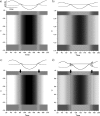Responses of recurrent nets of asymmetric ON and OFF cells
- PMID: 22379229
- PMCID: PMC3047201
- DOI: 10.1007/s10867-010-9207-3
Responses of recurrent nets of asymmetric ON and OFF cells
Abstract
A neural field model of ON and OFF cells with all-to-all inhibitory feedback is investigated. External spatiotemporal stimuli drive the ON and OFF cells with, respectively, direct and inverted polarity. The dynamic differences between networks built of ON and OFF cells ("ON/OFF") and those having only ON cells ("ON/ON") are described for the general case where ON and OFF cells can have different spontaneous firing rates; this asymmetric case is generic. Neural responses to nonhomogeneous static and time-periodic inputs are analyzed in regimes close to and away from self-oscillation. Static stimuli can cause oscillatory behavior for certain asymmetry levels. Time-periodic stimuli expose dynamical differences between ON/OFF and ON/ON nets. Outside the stimulated region, we show that ON/OFF nets exhibit frequency doubling, while ON/ON nets cannot. On the other hand, ON/ON networks show antiphase responses between stimulated and unstimulated regions, an effect that does not rely on specific receptive field circuitry. An analysis of the resonance properties of both net types reveals that ON/OFF nets exhibit larger response amplitude. Numerical simulations of the neural field models agree with theoretical predictions for localized static and time-periodic forcing. This is also the case for simulations of a network of noisy integrate-and-fire neurons. We finally discuss the application of the model to the electrosensory system and to frequency-doubling effects in retina.
Keywords: Bifurcations; Delayed feedback; ON and OFF cells; Recurrent connections.
Figures












Similar articles
-
Neural adaptation facilitates oscillatory responses to static inputs in a recurrent network of ON and OFF cells.J Comput Neurosci. 2011 Aug;31(1):73-86. doi: 10.1007/s10827-010-0298-4. Epub 2010 Dec 18. J Comput Neurosci. 2011. PMID: 21170577
-
Dynamics of driven recurrent networks of ON and OFF cells.Phys Rev E Stat Nonlin Soft Matter Phys. 2009 Oct;80(4 Pt 1):041912. doi: 10.1103/PhysRevE.80.041912. Epub 2009 Oct 9. Phys Rev E Stat Nonlin Soft Matter Phys. 2009. PMID: 19905347
-
Oscillatory response in a sensory network of ON and OFF cells with instantaneous and delayed recurrent connections.Philos Trans A Math Phys Eng Sci. 2010 Jan 28;368(1911):455-67. doi: 10.1098/rsta.2009.0229. Philos Trans A Math Phys Eng Sci. 2010. PMID: 20008411
-
Dynamics of networks of excitatory and inhibitory neurons in response to time-dependent inputs.Front Comput Neurosci. 2011 May 25;5:25. doi: 10.3389/fncom.2011.00025. eCollection 2011. Front Comput Neurosci. 2011. PMID: 21647353 Free PMC article.
-
Pattern Storage, Bifurcations, and Groupwise Correlation Structure of an Exactly Solvable Asymmetric Neural Network Model.Neural Comput. 2018 May;30(5):1258-1295. doi: 10.1162/NECO_a_01069. Epub 2018 Mar 22. Neural Comput. 2018. PMID: 29566351
Cited by
-
A cascade model of information processing and encoding for retinal prosthesis.Neural Regen Res. 2016 Apr;11(4):646-51. doi: 10.4103/1673-5374.180752. Neural Regen Res. 2016. PMID: 27212929 Free PMC article.
References
-
- Campbell SA, et al. Limit cycles, tori and complex dynamics in a second-order differential equation with delayed negative feedback J. Dyn. Diff. Equ. 199572130816.3404810.1007/BF02218819 - DOI
LinkOut - more resources
Full Text Sources
Miscellaneous

